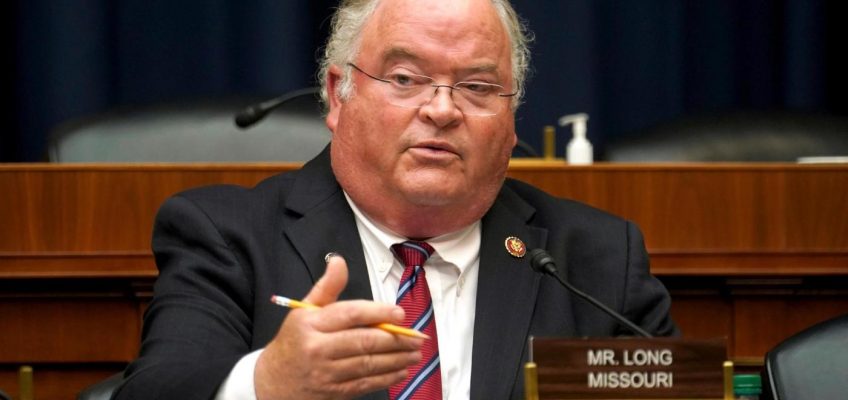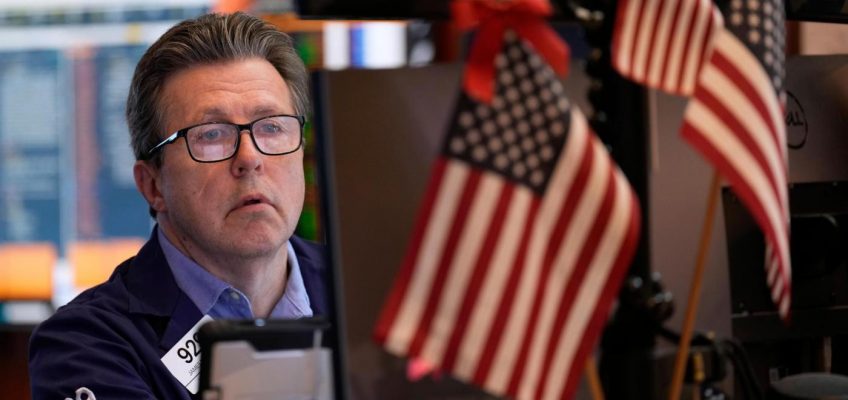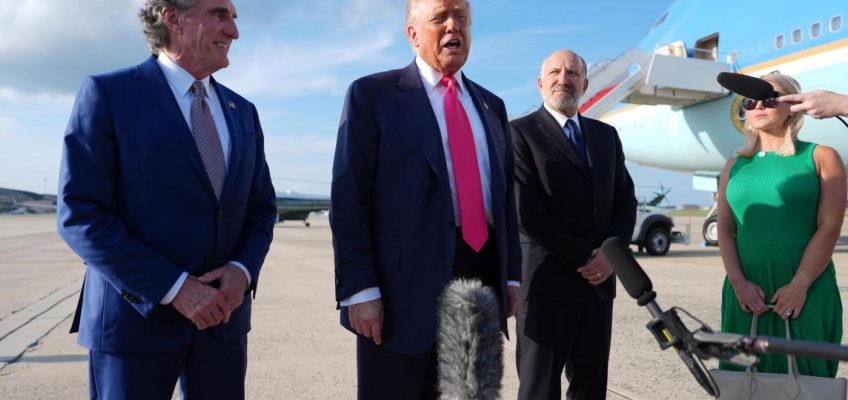By BRIAN SLODYSKO and WILL WEISSERT, Associated Press
WASHINGTON (AP) — If one theme has emerged in President Donald Trump’s second term, it’s this: He’s leveraged the power of his office for personal gain unlike anyone before in history.
From crypto coins to bibles, overseas development deals to an upcoming line of cellphones, Trump family businesses have raked in hundreds of millions of dollars since his election, an unprecedented flood of often shadowy money from billionaires, foreign governments and cryptocurrency tycoons with interests before the federal government.
“He is president and is supposed to be working in the public’s interest,” said James Thurber, an emeritus professor at American University, who has researched lobbying, campaign finance and political corruption for decades. “Instead, he is helping his own personal interest to grow his wealth. It’s totally not normal.”
The sums amassed by the Trump Organization, the collection of companies controlled by the president’s children, are far greater than those collected by the family during the president’s first term, when patronage of his hotels, resorts and golf courses was de rigueur to curry favor with the famously transactional commander-in-chief.
GrabAGun CEO Marc Nemati, center, board member Donald Trump, Jr., right, and financier Omeed Malik pose for a picture on the floor at the New York Stock Exchange in New York, Wednesday, July 16, 2025. (AP Photo/Seth Wenig)
The second time around, the Trump family’s ambitions are far grander, stretching from cyberspace to far-flung regions across the globe. One of Trump’s cryptocurrencies is conservatively estimated to have pulled in at least $320 million since January, while another received a $2 billion investment from a foreign government wealth fund. A third has sold at least $550 million in tokens.
His sons have jetted across the Middle East to line up new development deals, while his daughter and son-in-law are working with the Albanian government to build a Mediterranean island resort. Even first lady Melania Trump has inked a $40 million documentary deal with Amazon, whose founder, Jeff Bezos, was a frequent target of Trump during his first presidency and whose companies contract extensively with the federal government.
Drain the swamp?
The dealmaking is a rejection of Trump’s first-term pledge to “drain the swamp” in Washington and dwarfs the influence peddling efforts of former President Joe Biden’s family, whom Trump and his allies attacked as the “Biden Crime Family.”
While Democrats have condemned Trump for his overlapping roles as a beneficiary and president, he is not likely to face any immediate repercussions for such extensive conflicts-of-interest. Congress is controlled by fellow Republicans, and his administration is stocked with loyalists who have dismantled many guardrails of oversight. Last summer, the Supreme Court, with a conservative majority cemented by Trump, ruled that presidents have broad immunity from prosecution.
Even in the rare cases where Trump’s allies have urged caution, the president has ignored them. That’s what happened when he accepted a $400 million “beautiful, big, magnificent, free airplane” from the Qatari government. Trump said the Boeing 747 “would go directly” to his presidential library upon leaving office.
“It’s the Mount Everest of corruption” said Sen. Jeff Merkley, an Oregon Democrat.
GrabAGun board member Donald Trump, Jr., second from right, CEO Marc Nemati, fourth from right, and others ring the opening bell at the New York Stock Exchange in New York, Wednesday, July 16, 2025. (AP Photo/Seth Wenig)
Since Richard Nixon resigned in disgrace, presidents have gone to great lengths to avoid the appearance of such conflicts.
Jimmy Carter and Ronald Reagan kept assets in a “blind trust,” while George H.W. Bush used a “diversified trust,” which blocked him from knowing what was in his portfolio. His son, George W. Bush, used a similar arrangement.
Barack Obama was an exception, but his investments were mostly a bland mix of index funds and U.S. treasuries. During his first term, Trump even gave a nod toward ethics. He issued a moratorium on foreign deals. But instead of placing his assets in a blind trust like many of his predecessors, he handed the reins of the Trump Organization to his children, which kept his financial holdings close.
This time, he has made no such gesture. His sons, Eric and Donald Jr., are again running the business while Trump is in office. And though the White House says he is not involved in its day-to-day decisions, the trust he has established continues to profit. He promotes his resorts, merchandise and the family’s crypto ventures while residing in the White House, often from his account on Truth Social, the social media company he and his allies launched.
He’s also touted a line of Trump shoes, a Bible, which is made in China, and Trump guitars, one of which is a $1,500 Gibson Les Paul knockoff, featuring “Make America Great Again” fret inlays. Conservative groups and Republican committees have spent at least $25 million at Trump properties since 2015, with most of it coming from Trump’s own political organization, campaign finance disclosures show.
Trump embraces crypto
Yet, those ventures pale in comparison to his exploits in cryptocurrency, which offers perhaps the clearest example of the conflicts of interest that have come to dominate Trump’s second term.
Trump was once a crypto skeptic who declared that cryptocurrencies were “not money,” were based on “thin air” and seemed “like a scam.” By the time he was running again for president, however, he’d become a proponent of the industry.
“The difference now is he has realized that it can be his scam,” said Hilary Allen, a law professor at American University who specializes in banking and cryptocurrencies.
Trump has pledged to turn the U.S. into the “crypto capital of the world” and promised to roll back oversight of the industry.
Deregulation, of course, will help his own businesses. At the height of the campaign, Trump announced the launch of his own crypto coin and World Liberty Financial, a cryptocurrency firm that would be run by his sons and several business associates. Among those partners was Steve Witkoff, now one of Trump’s top diplomatic envoys.
The Trump Organization and World Liberty Financial declined to comment.
But it was also rooted in his 2024 campaign. At a crypto event at his Mar-a-Lago club in Florida in May 2024, he received assurances that industry figures would spend lavishly to get him reelected, The Associated Press previously reported.
Asked recently at the White House if he’d consider having his family business step back from its crypto investments to avoid questions about conflicts of interest, Trump said: “We’ve created a very powerful industry. That’s much more important than anything that we invest in.”
“I don’t care about investing. You know, I have kids and they invest in it, because they do believe in it,” Trump added of crypto. “But I’m president, and what I did do there was build an industry that’s very important. And, if we didn’t have it, China would.”
White House: Trump’s crypto push is not driven by self-interest
Harrison Fields, a White House spokesman, reiterated that Trump’s crypto boosterism isn’t driven by self-interest.
He “is taking decisive action to establish regulatory clarity for digital financial technology and to secure America’s position as the world’s leader in the digital asset economy,” Fields said.
“The Trump administration,” Fields added, “is fulfilling the president’s promise to make the United States the crypto capital of the planet by driving innovation and economic opportunity for all Americans.”
Trump is soon expected to sign cryptocurrency legislation approved by Congress on Thursday. Among the provisions is a ban on members of Congress issuing their own brand of a particular type of cryptocurrency. The prohibition does not extend to the president.
Fields said it was unfair to equate critics’ charges of conflicts of interest against Trump with the president’s own suggestions that Biden’s family benefited financially while he was in office.
He said Trump’s policies haven’t benefited the president personally and have nothing to do with his family’s financial concerns — and said Trump entered the White House an already successful businessman who didn’t need a political career to become rich.
Even so, Trump’s family is poised to benefit financially from the crypto industry’s growing clout. It holds a majority ownership stake that entitles them to 75% of earnings from their first coin, released last September, according to World Liberty Financial’s website.
The coin, $WLFI, was not an immediate success. Then, after the president’s election, sales took off.
Days before his inauguration, Trump announced a new meme coin, $Trump, during the “Crypto Ball,” a Washington gala intended to showcase a regulatory sea change he vowed to usher in.
“Time to celebrate everything we stand for: WINNING!” Trump posted to his X account. “Join my very special Trump Community. GET YOUR $TRUMP NOW.”
Trump’s meme coin generated at least $320 million in fees
Often created as a joke with no real utility, meme coins are prone to wild price swings that often enrich a small group of insiders at the expense of less sophisticated investors. $Trump soared to over $70, but its price soon collapsed, losing money for many. It has hovered around $10 since March. Trump did well, though. By the end of April, the coin had earned over $320 million in fees, according to an analysis by the crypto tracking firm Chainalysis.
A third cryptocurrency, a “stablecoin” called USD1, launched in April.
Civil rights work is slowing as Trump dismantles the Education Department, agency data shows
House Republicans grasp for response to demands for transparency in Epstein case
Searching for pennies: With the cut in federal funding public broadcasters are looking to cope
Federal Reserve says building renovation complies with law, defends costs
Attorneys sue to restore deportation protections for abused and neglected migrant children
There appear to be upsides for Trump’s cryptocurrency investors and associates.
Justin Sun, a Chinese-born crypto billionaire, has disclosed investing nearly $200 million in the Trumps’ various crypto ventures. Amid this spree, the Trump administration announced it had paused a securities fraud case against him. In June, Sun announced he was taking his crypto company, Tron, public after securing financing through a deal brokered by Eric Trump. Last week, Sun posted on Twitter that he was purchasing an additional $100 million worth of Trump’s meme coin.
Sun is not the only one. Changpen Zhao, a convicted felon who founded the crypto exchange Binance, was part of a megadeal in which a United Arab Emirates-controlled wealth fund invested $2 billion in the Trump stablecoin, USD1, which it used to purchase a stake in Zhao’s Binance.
The deal gave outsized publicity to World Liberty Financial and instantly made the stablecoin one of the top in the market. It will also allow the Trump family and their business partners to reinvest the $2 billion and collect interest, estimated to be worth as much as $80 million a year.
Soon after the purchase was announced, Trump granted the UAE greater access to U.S. artificial intelligence chips, which it had long sought. Binance and Zhao benefited, too.
Binance is restricted in the U.S. and entered a settlement with the Biden administration that sent Zhao to jail in 2024 after he pleaded guilty to failing to maintain an anti-money-laundering program. Prosecutors said he looked the other way as criminals used his platform to move money connected to child sex abuse, drug trafficking and terrorism.
In May, Trump’s Securities and Exchange Commission dropped the final federal enforcement action against Binance. Zhao, who goes by CZ, is now seeking a pardon. The White House says no decision has been made on issuing such a grant of clemency.
White House tour for top crypto investors
Trump announced several months ago a new promotion that would trade on his presidency: He was hosting a dinner at his Virginia golf club for the top 220 investors in his meme coin, $Trump, with a special White House tour for the top 25.
That fueled a temporary rise in the coin’s value. It also helped enrich the Trump Organization, which is entitled to collect fees when the coin is traded. A month later, Trump addressed attendees of the dinner, standing before a lectern with the presidential seal. The White House said at the time that it had nothing to do with the meme coin.
For decades, campaign contributions and lobbying have been governed by laws that place limits on how much donors can give, require a degree of transparency and limit how politicians can spend the money they raise. Trump’s venture into cryptocurrency effectively sidesteps these laws, legal and finance experts say.
“It’s a lot like the Trump Hotel from the first term, but what crypto has done is dispensed with the need for the hotel,” said Allen, the law professor. “Because crypto assets can be made out of thin air, he has found a way of creating an unlimited supply of assets to offer to people who want to give.”
Associated Press writer Aaron Kessler contributed from Washington.




